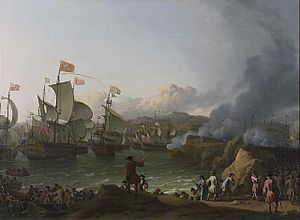Thomas Hopsonn facts for kids
Quick facts for kids
Sir Thomas Hopsonn
|
|
|---|---|

Portrait of Hopsonn, painted between 1705 and 1708 by Michael Dahl
|
|
| Born | 1643 |
| Died | 12 October 1717 (aged 74) Weybridge |
| Allegiance | |
| Service/ |
|
| Years of service | 1662–1702 |
| Rank | Vice Admiral |
| Commands held | Tiger (prize) Swann Bonaventure York Royal Katherine St Michael |
| Battles/wars | Third Anglo-Dutch War |
| Relations | Peregrine Hopson (son) Edward Hopson (nephew) |
Sir Thomas Hopsonn (born 1643 – died 1717) was an English naval officer and a member of parliament. He is most famous for his brave action during the Battle of Vigo Bay in 1702. In this battle, he led the charge that broke through a strong enemy barrier. After his time at sea, he became a Navy Commissioner and the governor of Greenwich Hospital.
Contents
Thomas Hopsonn was born in Shalfleet on the Isle of Wight in 1643. He was the second son of Captain Anthony Hopson. There's a popular story about how he joined the navy.
The Tailor's Apprentice Story
According to local tales, Thomas was working as a tailor's apprentice near Bonchurch. One day, news spread that warships were sailing near the island. He ran to the beach with his friends to see the amazing sight. This made him want to be a sailor! He quickly got into a boat, rowed out to the ships, and joined the admiral's ship as a volunteer.
However, some historians, like John Knox Laughton, say this exciting story might not be true.
No matter how he joined, Hopsonn was in the navy by 1662. He got his first official role as a second lieutenant in 1672. This was at the start of the Third Anglo-Dutch War. He fought in the Battle of Solebay and other battles during this war.
In 1676, he became a first lieutenant and sailed to the Mediterranean. During a fight against a Barbary Corsair ship, he bravely took a special sword (called a nimcha) from an enemy and used it against him. This sword is now kept in the National Maritime Museum. In 1678, he got his first command: a ship called the Tiger, which had been captured from the enemy.
Becoming a Captain
In 1682, Hopsonn was called back to sea to command the Swann. His ship helped move people from Tangier. After returning home, he also spent some time in the army.
In 1688, King James II gave him command of the Bonaventure. This ship was part of a fleet trying to stop a Dutch invasion. But Hopsonn secretly supported William of Orange in the Glorious Revolution.
Fighting for England
After the revolution, Hopsonn kept command of the Bonaventure. He helped relieve the siege of Derry in 1689. The next year, he commanded the York during the Battle of Beachy Head. His commander, Sir George Rooke, was very impressed with his bravery. They became good friends and worked together often.
Hopsonn then commanded the St Michael. On this ship, he fought alongside Rooke in the Battle of Barfleur in 1692.
Rising to Admiral
In May 1693, Hopsonn was promoted to Rear Admiral of the Blue. His first big mission was to help Sir George Rooke protect a large group of merchant ships sailing to Smyrna. The French admiral Comte de Tourville attacked the convoy at the Battle of Lagos, scattering the ships. But Hopsonn was not blamed for what happened.
Important Missions
He was promoted again to Vice Admiral of the Blue. In 1694, he sailed home, safely guiding nearly a hundred ships from Cadiz to England. For the next two years, he patrolled the Channel, trying to catch a famous French privateer named Jean Bart.
In 1698, he was elected to represent Newtown on the Isle of Wight in Parliament. He served there until 1705. He also went to the Baltic with Rooke in 1700 to help with a peace effort.
The Battle of Vigo Bay
In 1702, Hopsonn was again under the command of Sir George Rooke. Their fleet tried to capture Cádiz, but it didn't work out. On their way home, they learned that the Spanish treasure fleet was in Vigo Bay in Northern Spain.
The ships in Vigo Bay were protected by a strong barrier called a boom. This boom was made of ship masts chained together, guarded by forts and French warships. Hopsonn was chosen to lead the attack aboard his flagship, the Torbay.
In the early morning of October 23, 1702, Hopsonn bravely crashed his ship through the boom while under heavy fire. Another ship, which was meant to be a fire ship (a ship set on fire to destroy enemy ships), was placed next to the Torbay. This fire ship was full of snuff (a type of tobacco). When it exploded, the snuff flew into the air and helped put out some of the flames on the Torbay! The rest of the fleet followed Hopsonn into the harbor. The French and Spanish ships were badly defeated, losing 34 ships and much treasure.
Later Life and Family
When he returned to England, Queen Anne knighted Hopsonn for his heroic actions at Vigo Bay. He then retired from active service. He became an Extra Commissioner of the Navy and served as governor of Greenwich Hospital from 1704 to 1708.
He moved to Weybridge in Surrey, where he built a house called Vigo House. Sir Thomas Hopsonn died there on October 12, 1717.
His Family
Thomas Hopsonn married Elizabeth Timbrell in 1680. They had eight children:
- Mary (1682–1715)
- Elizabeth (1686–1758)
- Charles (born 1688)
- Ann (1692–1763)
- Grace (1693–1768)
- Peregrine Thomas (1696–1759), who later became the Governor of Nova Scotia.
- James (born 1700)
- Martha (born 1702)
His nephew, Edward Hopson, also joined the navy and became a vice-admiral.
Images for kids




